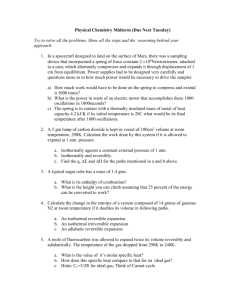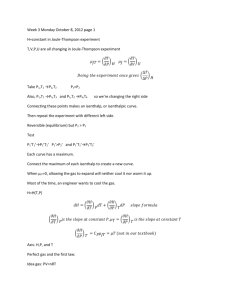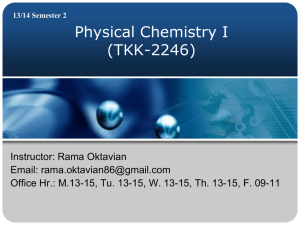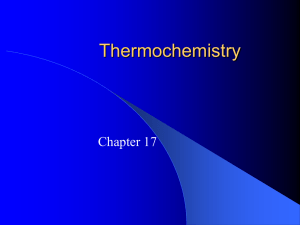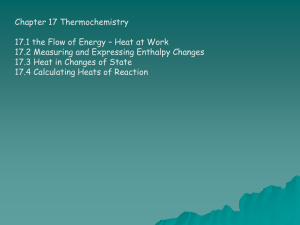Q cold
advertisement
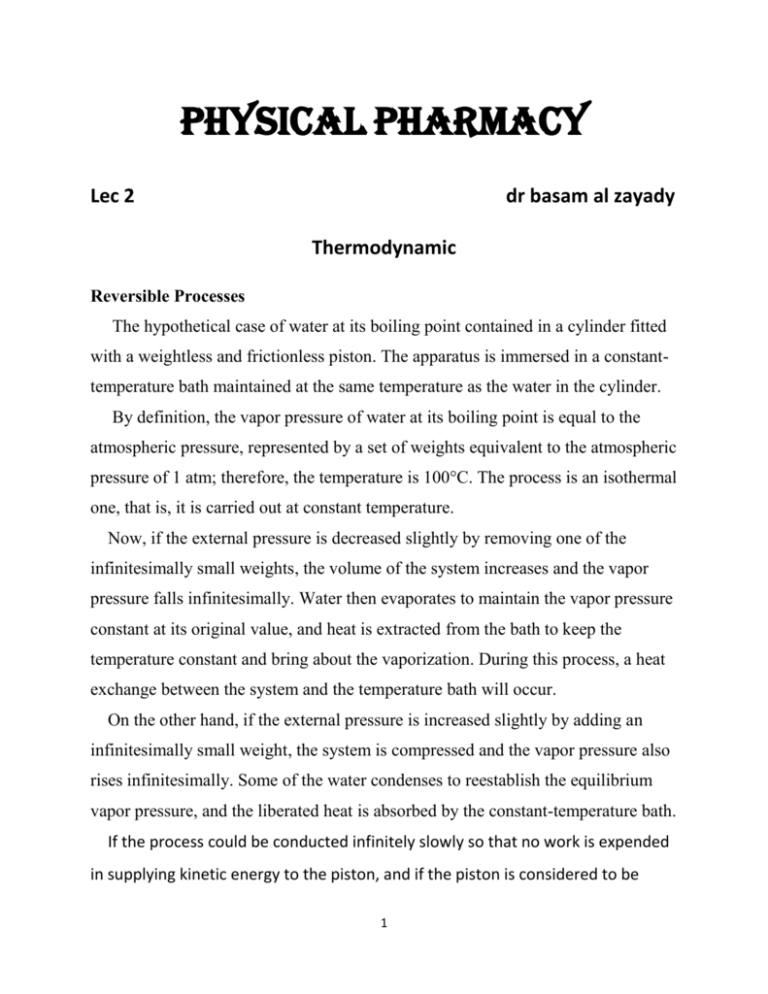
Physical pharmacy Lec 2 dr basam al zayady Thermodynamic Reversible Processes The hypothetical case of water at its boiling point contained in a cylinder fitted with a weightless and frictionless piston. The apparatus is immersed in a constanttemperature bath maintained at the same temperature as the water in the cylinder. By definition, the vapor pressure of water at its boiling point is equal to the atmospheric pressure, represented by a set of weights equivalent to the atmospheric pressure of 1 atm; therefore, the temperature is 100°C. The process is an isothermal one, that is, it is carried out at constant temperature. Now, if the external pressure is decreased slightly by removing one of the infinitesimally small weights, the volume of the system increases and the vapor pressure falls infinitesimally. Water then evaporates to maintain the vapor pressure constant at its original value, and heat is extracted from the bath to keep the temperature constant and bring about the vaporization. During this process, a heat exchange between the system and the temperature bath will occur. On the other hand, if the external pressure is increased slightly by adding an infinitesimally small weight, the system is compressed and the vapor pressure also rises infinitesimally. Some of the water condenses to reestablish the equilibrium vapor pressure, and the liberated heat is absorbed by the constant-temperature bath. If the process could be conducted infinitely slowly so that no work is expended in supplying kinetic energy to the piston, and if the piston is considered to be 1 frictionless so that no work is done against the force of friction, all the work is used to expand or compress the vapor. Then, because this process is always in a state of virtual thermodynamic equilibrium, being reversed by an infinitesimal change of pressure, it is said to be reversible. If the pressure on the system is increased or decreased rapidly or if the temperature of the bath cannot adjust instantaneously to the change in the system, the system is not in the same thermodynamic state at each moment, and the process is irreversible. Although no real system can be made strictly reversible, some are nearly so. One of the best examples of reversibility is that involved in the measurement of the potential of an electrochemical cell using the potentiometric method. Maximum Work The work done by a system in an isothermal expansion process is at a maximum when it is done reversibly. This statement can be shown to be true by the following argument. No work is accomplished if an ideal gas expands freely into a vacuum, where P = 0, because any work accomplished depends on the external pressure. As the external pressure becomes greater, more work is done by the system, and it rises to a maximum when the external pressure is infinitesimally less than the pressure of the gas, that is, when the process is reversible. Of course, if the external pressure is continually increased, the gas is compressed rather than expanded, and work is done on the system rather than by the system in an isothermal reversible process. So from the ideal gas law PV= nRT Where n is the number of moles of gas R is the gas constant 2 W= - p ∆V W= - nRT (∆V/V) W= - nRT In(V2/V1) And from boyles law V2/V1=P1/P2 Then W max = - nRT In(P1/P2) Then the maximum work done for a system that is expanded in reversible fashion is where Pex was replaced by P because the external pressure is only infinitesimally smaller than the pressure of the system. In similar fashion, it can be deduced that the minimum work in a reversible compression of the system will also lead to equation above, because at each stage Pex is only infinitesimally larger than P. Note that in expansion, V2 > V1, and ln(V2/V1) is a positive quantity; therefore, the work is done by the system, so that its energy decreases (negative sign). When the opposite is true, V2 < V1, and ln(V2/V1) is negative due to gas compression, work is done on the system, so that its energy increases (positive sign). The process itself determines the sign of W and ΔE. Heat content (enthalpy): When the work of expansion is done at constant pressure (in most chemical studies where the reaction vessel is open to the atmosphere and P= 1 atm approximately), so by using the equation, W = -P ΔV = -P(V2 - V1) and under these conditions, the first law can be written as ∆E = Qp – P(V2 - V1) (E2 –E1) = Qp – P(V2 - V1) 3 where QP is the heat absorbed at constant pressure. Rearranging the equation results in Qp = (E2 + PV2 ) – (E1 + PV1) The term E + PV is called the heat content or enthalpy (H), and the increase in enthalpy, ΔH, is equal to the heat absorbed by the system at constant pressure. It is the heat required to increase the internal energy and to perform the work of expansion, as seen by substituting H in equation above: Qp = H2 – H1 = ∆H and the first law equation become: ∆H = ∆E + P ΔV When a chemical process is carried out at constant pressure, the heat evolved or absorbed, per mole, can be identified as ∆H (this heat is independent of the number of steps and the mechanism of the reaction. It depends only on the initial and final conditions. specific symbols and names have been devised to identify ∆H with particular processes. For example, the heat absorbed by solid on melting is called the heat of fusion and labeled ∆Hf or ∆Hm. For a chemical reaction ∆H is called a heat of reaction. The heat of reaction may be positive (heat is absorbed) called endothermic or negative (heat is evolved) called exothermic. ∆Ho is the heat content at standard condition (25 Co, 1 atm pressure) ∆H is expressed as cal/mole. 4 In solution reactions, the P Δ V terms are not significant, so that ΔH [congruent] ΔE. This close approximation does not hold, however, for reactions involving gases. Table: Modified First-Law Equations for Processes Occurring Under Various Conditions Specific condition Process Common means for Modification for the first establishing the condition law dE=dq + dw under the stated condition Constant heat dq = 0 Adiabatic Insulated vessel dE = dw Reversible process dT = 0 isothermal Constant temp bath dW = W max dV = 0 Isometric Closed vessel of constant dW=-pdV=0 dE=Qv (isochoric) volume isobaric Reaction occurring in an dH = Qp open container at constant dE=dH-Pdv at constant temperature Constant volume Constant pressure dP = 0 atmospheric pressure Heat capacity: The molar heat capacity C , is defined as the heat q required to raise the temperature of one mole of the substance by one degree C = q/dT Differential and integral heat of solution: When a mole of a solute dissolved, the heat absorbed or liberated is not a constant quantity but varies with the concentration of the solution. Thermochemistry :It is the study that deals with the heat changes accompanying isothermal chemical reactions at constant pressure or volume, from which values of ΔH or ΔE can be obtained. 5 Heat of Formation For any reaction represented by the chemical equation aA + bB = cC + dD the enthalpy change can be written as where = enthalpy per mole (called the molar enthalpy) and a, b, c, and d are stoichiometric coefficients. It is known that only the molar enthalpies of compounds, either as reactants or products, contribute to the change of enthalpy of a chemical reaction. Hess's Law and Heat of Combustion It is not possible to directly measure the heats of formation of every known compound in equation . Incomplete or side reactions often complicate such determinations. However, Hess showed that because ΔH depends only on the initial and final states of a system, thermochemical equations for several steps in a reaction could be added and subtracted to obtain the heat of the overall reaction. The principle is known as Hess's law of constant heat summation and is used to obtain heats of reaction that are not easily measured directly. The Efficiency of a Heat Engine An important consideration is that of the possibility of converting heat into work. The spontaneous character of natural processes and the limitations on the conversion of heat into work constitute the second law of thermodynamics. Falling water can be made to do work owing to the difference in the potential energy at 6 two different levels, and electric work can be done because of the difference in electric potential. A heat engine (such as a steam engine) likewise can do useful work by using two heat reservoirs, a “source” and a “sink,” at two different temperatures. Only part of the heat at the source is converted into work, with the remainder being returned to the sink (which, in practical operations, is often the surroundings) at the lower temperature. The fraction of the heat, Q, at the source converted into work, W, is known as the efficiency of the engine: The efficiency of even a hypothetical heat engine operating without friction cannot be unity because W is always less than Q in a continuous conversion of heat into work according to the second law of thermodynamics. Imagine a hypothetical steam engine operating reversibly between an upper temperature T hot and a lower temperature T cold. It absorbs heat Q hot from the hot boiler or source, and by means of the working substance, steam, it converts the quantity W into work and returns heat Q cold to the cold reservoir or sink. Carnot proved that the efficiency of such an engine, operating reversibly at every stage and returning to its initial state (cyclic process), could be given by the expression It is known that heat flow in the operation of the engine follows the temperature gradient, so that the heat absorbed and rejected can be related directly to temperatures. Lord Kelvin used the ratios of the two heat quantities Q hot and Q cold of the Carnot cycle to establish the Kelvin temperature scale: 7 By combining equations, we can describe the efficiency by It is observed from equation that the higher T hot becomes and the lower T cold becomes, the greater is the efficiency of the engine. When T cold reaches absolute zero on the Kelvin scale, the reversible heat engine converts heat completely into work, and its theoretical efficiency becomes unity. This can be seen by setting T cold = 0. Because absolute zero is considered unattainable, however, an efficiency of 1 is impossible, and heat can never be completely converted to work. If T hot = T cold, the cycle is isothermal and the efficiency is zero, confirming the earlier statement that heat is isothermally unavailable for conversion into work. 8


